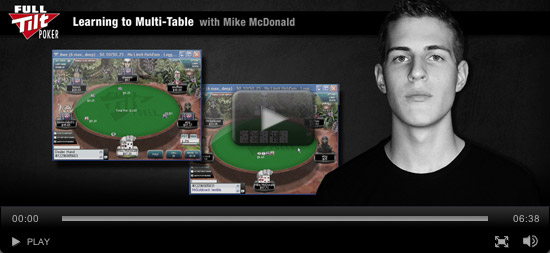Learning to Multi-Table by Mike McDonald
Many players new to online poker find multi-tabling – playing more than one table at once – intimidating. While it might seem this way at first, there are several things that you can do to get the most out of your experience right from the start.
One of the first things to consider is how to arrange your tables. Tiling your tables so that they’re beside each other without overlap lets you see the action at every table at all times. A second option is cascading your tables. This is particularly useful if you have a smaller monitor and are playing lots of tables. Personally, I prefer to tile my tables so that I’ve got a better view of all of the action at once – I find that I time out a bit more and miss out on some good opportunities when I’ve got them cascaded and can’t see everything at once. Try both formats and decide which works best for you.
Take advantage of the FTP Hand Replayer to learn from big pots. This gives you the chance to review how your opponents played their hands and then make player notes for future reference. You can make notes by right-clicking on the player and entering information about their play, like “bluffs too much” or “very aggressive player”. Save your notes and use them to identify players to avoid or players you’re willing to get into pots with.
When you play multiple tables and catch big hands at more than one table at a time, you need to make sure you get maximum value out of each one. To begin, you should be aware of how you got into the hand – experience will help with this. Occasionally, if I’m playing too many tables, I’ll be in the middle of a hand and wonder how I got there. That’s what you want to avoid. Play a comfortable number of tables so you don’t limit your capabilities. Over time, you’ll be able to handle more tables.
It’s also important to keep track of how many tables your opponents are playing. If a player is at more than one table, it’s likely that he’s a regular Multi-Table player. This is important because it affects the way your opponents play. Most Multi-Tablers will play fairly straightforward and won’t make elaborate bluffs. When I’m only playing one table, I’m more likely to make an aggressive move than when I’m playing four tables or more.
I’d also recommend that you buy in for the maximum amount on each table and keep it topped up so you can capitalize on the power of a full stack. Generally, I think it’s a good idea to top up when you lose a pot – I like to stay as deep as possible. When I get into a big pot for full stacks, I’ll usually have the best hand and I want to be able to get as much value as I can – I’d rather have a full stack than 90% of a stack so that I get maximum value from that situation.
Keep these things in mind as you start multi-tabling and you’ll find it’s not as intimidating as it initially seemed.

